“Whiz Kids” with extremely high Intelligence Quotient

Abstract
A group of children that during the previous years has attracted the interest of researchers are gifted children that their Intelligence Quotient is 160+. These children are usually characterized as highly gifted or exceptionally gifted children. In everyday life, people tend to characterize this group of children as «whiz-kids» or geniuses and among the various characteristics these children hold are the very early language development and development of reading, high levels of energy and the advanced use of humor. Early development in the aforementioned areas has positive outcomes in the cognitive and socioemotional development of these children, however, they face a number of difficulties in comparison to moderately gifted children, mainly in their social development, such as social isolation. Furthermore, a great percentage of them is not identified at an early stage or may not be identified at all. It is of great importance that special support and specialized educational interventions are provided to this certain group of students, such as counseling, summer programs, enrichment, home-schooling and acceleration. These interventions need to be a priority for education policies in order for exceptionally gifted children to innovate, to originate and unlock their full inherent potential
Article Details
- How to Cite
-
Μητσοπούλου Ε., & Αντωνίου Α.-Σ. (2021). “Whiz Kids” with extremely high Intelligence Quotient. Pedagogikos Logos, 27(1), 15–32. https://doi.org/10.12681/plogos.27903
- Section
- Articles

This work is licensed under a Creative Commons Attribution-NonCommercial-NoDerivatives 4.0 International License.
Οι Συγγραφείς που δημοσιεύουν εργασίες τους σε αυτό το περιοδικό συμφωνούν στους παρακάτω όρους:
- Οι Συγγραφείς διατηρούν τα Πνευματικά Δικαιώματα και χορηγούν στο περιοδικό το δικαίωμα της πρώτης δημοσίευσης, ενώ ταυτόχρονα τα πνευματικά δικαιώματα της εργασίας προστατεύονται σύμφωνα με την χρήση άδειας που υιοθετεί ο «Παιδαγωγικός Λόγος - Περιοδική Έκδοση για τις Επιστήμες του Ανθρώπου και την Εκπαίδευση» : Αναφορά Δημιουργού – Μη Εμπορική Χρήση – Όχι Παράγωγα Έργα 4.0 (CC BY-NC-ND). Αυτή η άδεια επιτρέπει στους άλλους να έχουν πρόσβαση στο έργο και να το μοιράζονται με άλλους, εφόσον κάνουν αναφορά σε αυτό, ωστόσο δεν μπορούν να το αλλάξουν με κανένα τρόπο ούτε να το χρησιμοποιούν για εμπορική χρήση.
- Οι συγγραφείς μπορούν να συνάπτουν ξεχωριστές και πρόσθετες συμβάσεις και συμφωνίες για τη μη αποκλειστική διανομή της εργασίας, όπως δημοσιεύτηκε στο περιοδικό αυτό (π.χ. κατάθεση σε ένα ακαδημαϊκό καταθετήριο ή δημοσίευση σε ένα βιβλίο), με την προϋπόθεση της αναγνώρισης και την αναφοράς της πρώτης δημοσίευσης σε αυτό το περιοδικό.
- Το περιοδικό επιτρέπει και ενθαρρύνει τους συγγραφείς να καταθέτουν τις εργασίες τους μέσω διαδικτύου (π.χ. σε ένα ακαδημαϊκό καταθετήριο ή στους προσωπικές τους ιστοσελίδες) πριν και μετά από τις διαδικασίες της δημοσίευσης, καθώς αυτό μπορεί να οδηγήσει σε παραγωγική ανταλλαγή ιδεών και σκέψεων, καθώς επίσης και σε γρηγορότερη και μεγαλύτερη χρήση και ευρετηρίαση της δημοσιευμένης εργασίας


